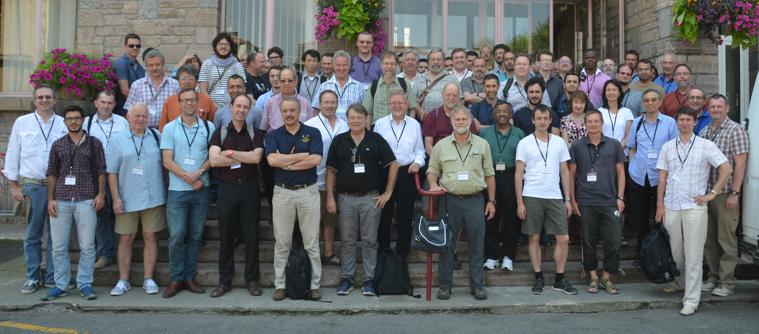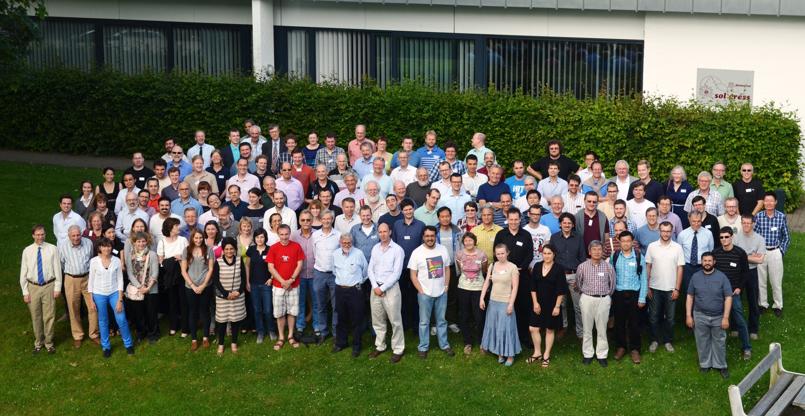Trip Report: NACONF 2015 and Sparse Days III
I have just returned from two meetings in Europe, the 26th Biennial Conference on Numerical Analysis at the University of Strathclyde in Glasgow, Scotland, and Sparse Days III in Saint-Girons, France.
Contents
26th Biennial Conference on Numerical Analysis
The Biennial Conference on Numerical Analysis in Scotland has a long history. The first two meetings were held at the University of St. Andrews in 1965 and 1967. The meetings moved to the University of Dundee in 1969. They were held there every two years, under the leadership of Ron Mitchell, until his retirement in 2007. They moved to the University of Strathclyde in 2009, under the leadership of Alison Ramage. This meeting was the 26th and the 50th anniversary. Although this is a premier conference series in numerical analysis, it was the first time I participated.
University of Strathclyde
The University of Strathclyde is a public research university located in Glasgow, Scotland. The university's name comes from the "Valley of the River Clyde". The school is Scotland's foremost institution of science and engineering.
The Conference
The conference was held June 23rd through 26th. I was one of a dozen invited speakers -- five from the US, four from continental Europe, and three from the UK.
Almost all of the participants gave half-hour talks. There were 168 talks organized in seven parallel sessions. Many of the talks were in one of twelve minisymposia. Sample minisymposia titles include "Stable and accurate discretisations for convection-dominated problems", "City analytics", "Chebfun: new developments, cool applications and on the horizon", and "Numerical linear algebra for optimsation and data assimilation".
A. R. Mitchell Lecture
Two of the invited lectures are given special emphasis to honor British numerical analysts. The A. R. Mitchell Lecture honors the University of Dundee's Ron Mitchell who was the dominant force in this conference for forty years.
This year the lecture was given by Mike Giles of the University of Oxford on "Multilevel Monte Carlo Methods". I knew nothing about this subject before his talk and I learned a great deal. His abstract provides a link to a web page featuring a survey paper and MATLAB codes, <http://people.maths.ox.ac.uk/gilesm/acta>
Fletcher-Powell Lecture
The Fletcher-Powell Lecture honors two mathematicians known for their work in optimization algorithms, including the Davidon-Fletcher-Powell, DFP, formula. Mike Powell, from Cambridge University, had passed away in April. Roger Fletcher, from the University of Dundee, attended the lecture.
This year the lecture was given by my long-time friend Mike Saunders from Stanford. He talked about "Experiments with linear and nonlinear optimization using Quad precision." He has used the GFortran compiler to build a version of his MINOS optimization software with the REAL*16 floating point datatype. He tackled flux balance analysis models of metabolic networks that involve coefficients ranging over 15 or 16 orders of magnitude. Ordinary double precision, that is Fortran's REAL*8, cannot do the job.
Sparse Days in St Girons III
The history of the Sparse Days in St Girons conference is itself sparse. There have been just two previous conferences, one in 1994 and one in 2003. The conference is part of a program on "High Performance Linear and Nonlinear Methods for Large Scale Applications" organized by CIMI, the French Centre International de Mathematique et d'Informatique in Toulouse.
Organizers of Sparse Days in St Girons III included my buddies Iain Duff, who splits his time between Rutherford Appleton Laboratory in the UK and the Parallel Algorithms Group at CERFACS in Toulouse; Jack Dongarra, from the University of Tennessee; and Jim Demmel, from the University of California, Berkeley.
St Girons
St Girons is a picturesque town in the French Pyrenees, not far from the border with Spain. The Tour de France sometimes passes through here. We met in the town's only cinema, which is air conditioned. This turned out to be fortunate planning because a heat wave hit that week, June 28th through July 2nd, with temperatures in the mid 30s C, which is mid 90s F.
The Conference
The format for this conference was quite different from the one the previous week in Scotland. There were only about half as many attendees, around 100. There were no invited talks and no parallel sessions. Anyone who wanted to give a talk gave one. There were 42 talks, most of them half an hour.
Interesting Talks
Tim Davis, MathWorks consultant on sparse matrices, who recently moved to Texas A&M, talked about "Sparse SVD, and a GPU-accelerated sparse QR".
Bora Ucar of Ecoles Normales Superieures in Lyon talked about "Two approximation algorithms for bipartite matching on multicore architectures." The analysis of his algorithm happened to involve my old friend, the Lambert W function.
Joost Rommes, from Mentor Graphics in the Netherlands, talked about "Challenges in numerical simulation of electrical networks."
Alex Pothen, from Purdue, talked about "The Virtual Scalpel: real-time matrix computations and finite elements for surgery."
Dan Sorensen, from Rice, talked about "A DEIM induced CUR factorization." This title means that C is some columns of a matrix A, R is some rows of A, and DEIM is an algorithm that finds U so that the product CUR is a good low approximation to A.
Martin Gander, from Universite de Geneve, talked about "Five decades of time parallel integration." I was particularly interested in his talk because I knew something about the subject many years ago, but was not familiar with recent developments. At first, it might seem impossible to parallelize a computation that involves stepping along in time. But Martin gave an overview of four different approaches to how this can be done.
Another Cleve
There is another Cleve in this business. Cleve Ashcraft of LSTC, Livermore Software Technology Corporation, is actually a "grandstudent". His PhD advisor at Yale was Stan Eisenstat, who was my PhD advisee when I was a visiting professor at Stanford. At Sparse Days, Cleve talked about "Separability, partitions and coverings.". His talk didn't mention the applications he is deeply involved in at LSTC, which are the developers, among other things, of the crash analysis software LS-DYNA. If you want to see a hint of some serious use of dynamic finite element calculations, take at the LSTC web pages.
This is the group photo from Sparse Days in St Girons III. There are two Cleves. Cleve Ashcraft is the guy with the green shirt and grey beard in the front row. Can you find the other one? (Thanks to Pierre-Henri Cros for the photo, and for handling local arrangements.)

- Category:
- History,
- Numerical Analysis,
- People,
- Travel
 Cleve’s Corner: Cleve Moler on Mathematics and Computing
Cleve’s Corner: Cleve Moler on Mathematics and Computing The MATLAB Blog
The MATLAB Blog Guy on Simulink
Guy on Simulink MATLAB Community
MATLAB Community Artificial Intelligence
Artificial Intelligence Developer Zone
Developer Zone Stuart’s MATLAB Videos
Stuart’s MATLAB Videos Behind the Headlines
Behind the Headlines File Exchange Pick of the Week
File Exchange Pick of the Week Hans on IoT
Hans on IoT Student Lounge
Student Lounge MATLAB ユーザーコミュニティー
MATLAB ユーザーコミュニティー Startups, Accelerators, & Entrepreneurs
Startups, Accelerators, & Entrepreneurs Autonomous Systems
Autonomous Systems Quantitative Finance
Quantitative Finance MATLAB Graphics and App Building
MATLAB Graphics and App Building







Comments
To leave a comment, please click here to sign in to your MathWorks Account or create a new one.